I usually encounter raised eyebrows when I mention anything about sake breweries, because people are puzzled that ‘rice wine’ is actually brewed. Others are irritated because they assume that sake is distilled, as it can be quite strong. So what is sake?
Sake is the traditional Japanese beverage that has been brewed for 1.000 years like it is today from rice and rice alone. Of course you need yeast, water and koji (a mold that is grown on rice to break the starch into sugar) for the fermentation, but no other grain than rice is allowed. The fact that sake is brewed from a grain makes it more a beer than a wine. But given its complexity of flavors and the amount of flavor nuances (about 400), sake relates more to wine (which has about 200 flavor nuances). And even though sake has a natural alcohol content of 16-20%, is not distilled and not even remotely related to any spirit. In the end sake is sake. A beverage of its own. Subtle, diverse, complex and very enjoyable.
So how is sake made in a nutshell?
Rice is being polished, washed, soaked and then steamed in this order. Afterwards it gets mixed with yeast, water and koji in a small open tank and is then allowed to ferment for about two weeks (sometimes four). After those initial two (four) weeks that mixture (Moto) is transferred to a large tank and more steamed rice, water and koji is added three times in four days. This mixture is now called Moromi. The Moromi will ferment in a large open tank for the next 18 to 32 days after which it will be pressed, filtered, often pasteurized and sometimes blended.
Sounds pretty straight forward, right? So how can something so ‘simple’ develop such a variety of flavors? Because basically ANY variation in EACH and EVERY STEP in the process has an influence on the taste.
- What type of water is used and its chemical composition.
- Which type of rice is being used and where the rice has been grown.
- The weather during rice growing season as well as during the brewing process
- How much and how fast the rice is being polished.
- How long the rice is being washed, how long it is being soaked (Japanese brew masters go down to adjust the time by seconds) and steamed
- How the koji mold propagates on the rice (which is adjusted by humidity and temperature – again, in the 0,5 to 1 degree/percent- range)
- What type of yeast is being used and the fermenting temperature
- …
The list goes on and on, but I think you get the idea that brewing sake is an art and certainly not straight forward. All the adjustments are decided by the toji (master brewer) based on intuition, experience and his five senses. Machines and computers can only inadequately replace those skills and are therefore only used for ordinary, low grade sake. Thus it doesn’t come on a surprise that it takes decades for a young kurabito (brewery worker) to get the necessary experience and to sharpen his senses to become a toji – if at all.
